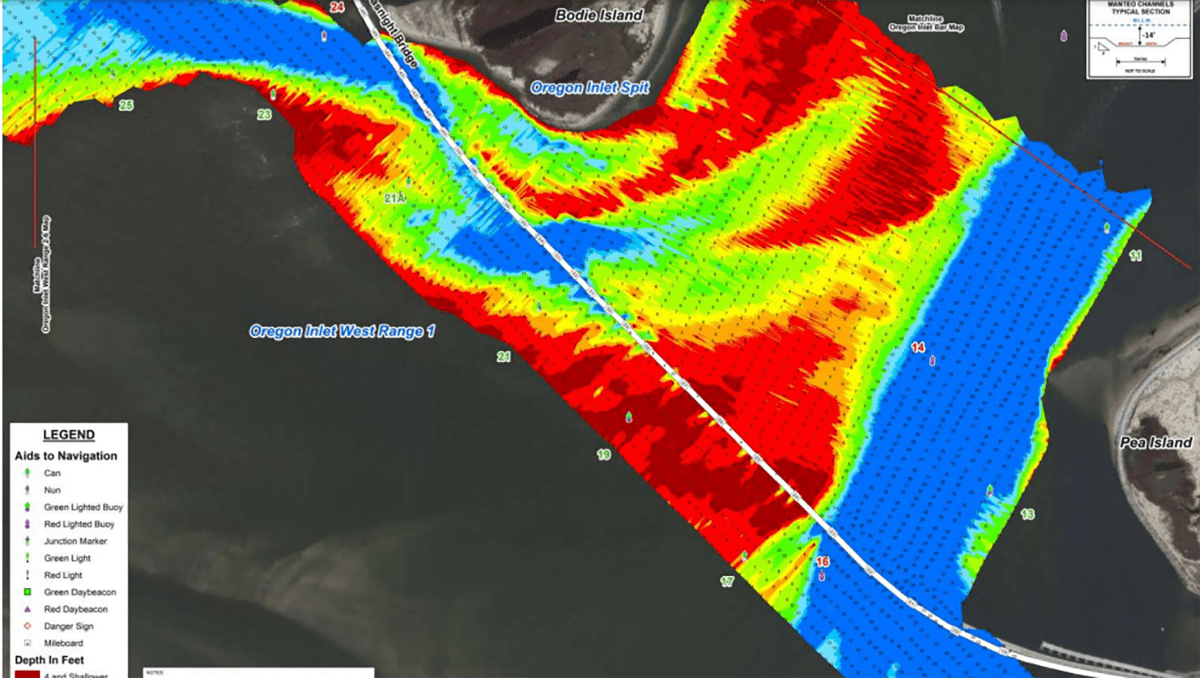
MANTEO — Nearly 20 years ago, the White House Council on Environmental Quality seemed to have finally put its federal sword through the heart of the Oregon Inlet twin-jetty proposal, a project that Congress had approved in 1970 after it had brewed in local committee rooms for at least a decade.
But now, as shoaling has continued to create hazardous conditions for vessels in Oregon Inlet, North Carolina U.S. Rep. Greg Murphy, a Republican representing North Carolina’s 3rd District, is asking the U.S. Army Corps of Engineers to take another look at building twin jetties. Murphy and the bill’s cosponsor Rep. Rob Wittman, R-Va., have introduced legislation directing the Corps to conduct a new feasibility study for construction of the proposed jetties.
Supporter Spotlight
“While dredging has been somewhat effective in easing the issues at Oregon Inlet, it’s not a permanent solution,” Murphy said Thursday in a press release. “It’s clear that a dual jetty system, which requires an act of Congress, is necessary for long-term navigation, commerce and flood control purposes.”

Murphy had announced introduction of the legislation, the Oregon Inlet Jetty Feasibility Study Act, Aug. 19 during a press conference in Manteo, but the bill was not published on the congressional website until Thursday.
The legislation needs House and Senate approval. The study would then have to be done within eight months, and a report submitted to Congress within a year.
In an interview after the press conference, Murphy was uncertain what support the measure would receive in Congress, although he said he has had good discussions with members and with the Corps about the need for the jetties.
Murphy also said that the feasibility study is not funded. The congressman, who had voted against Biden’s Infrastructure Investment and Jobs Act and the Inflation Reduction Act, said he did not expect either bill to provide funds for the study, but he would welcome wherever the funding could be found.
Supporter Spotlight
As of late Thursday, the Congressional Budget Office cost estimate for the measure had not been received, according to the congressional legislative website.
At the press event, Murphy acknowledged the complexity of the more-than-60-year history of Oregon Inlet dual-jetty plan, which involved countless studies, hundreds of meetings from local boards to congressional committees, and millions of dollars.
“It’s really going to take a concerted effort,” he said. “This is the most studied inlet in the country, but we have to start from scratch again.”
In May 2003, when the Council on Environmental Quality announced the consensus agreement between jurisdictional federal agencies not to proceed with the proposed project, part of the explanation was that economic and environmental data created uncertainties about any benefits.
Those questions, “and the risk to important resources,” Council Chair James L. Connaughton said at the time, “weigh against proceeding with the project.”
Although Outer Banks watermen were deflated, it didn’t take long before they began pursuit of new efforts — so far with no success — to get the project built. Proponents say the jetties, which would be walls on either side of the inlet by the Marc Basnight Bridge, would block sand buildup in the navigational channel.
They say that the jetties are needed to prevent loss of life and vessels in the inlet, to protect water quality, and to protect the enormous economic benefit of the inlet to the local economy and the fishing and boating communities.

The state and Dare County have been consistently in support of the project.
After Congress had authorized the jetties in 1970, it had never funded the estimated $100 million or so cost. The project called for the Corps to dredge a 20-foot by 400-foot navigation channel for deep-draft fishing vessels and construct two long jetties to divert sand from the channel.
Oregon Inlet, the only ocean to sound passage between Virginia and Hatteras, is known for its dangerous currents and constantly shifting shoals.
Barton Grover, Dare County waterways administrator, said the county currently allocates $3 million for Oregon Inlet dredging each year. With state match, that has meant $9 million in nonfederal funds have been available for dredging each year.
The inlet and its shoreline are within Cape Hatteras National Seashore, which has historically been opposed to the jetties. Opponents, including numerous environmental groups and public agencies, say that the jetties would cause serious erosion farther south and would have a detrimental effect on fish populations.
Located adjacent to the Pea Island National Wildlife Refuge and between the Atlantic Ocean and Pamlico Sound, the inlet and its marshes are important fish nurseries and habitats for dozens of species of fish, including crab, shrimp, sharks, bluefish and numerous other finfish and shellfish.
In 2014, Duke University coastal scientist Orrin Pilkey — a longstanding and vocal opponent of the jetty project — expressed to Coastal Review his shock that the state was studying how to get control of the inlet so the jetties could be built.
“I’m extremely concerned and appalled that the issue still exists,” Pilkey said at the time. “The jetties have been thoroughly discredited on all levels.”
After the council killed off the jetty project in 2003, it promised that the federal government would provide resources for more surveys and dredging of the inlet. Although both improved, the dredging has proved inadequate, whether because of funding shortages or increased demand.
The dredge Miss Katie, a private-public in partnership with Dare County and the state, arrived in Wanchese last week. The hopper dredge, built by private company EJE, will be taking over much of the dredging responsibilities in Oregon Inlet once it starts work in coming weeks.








